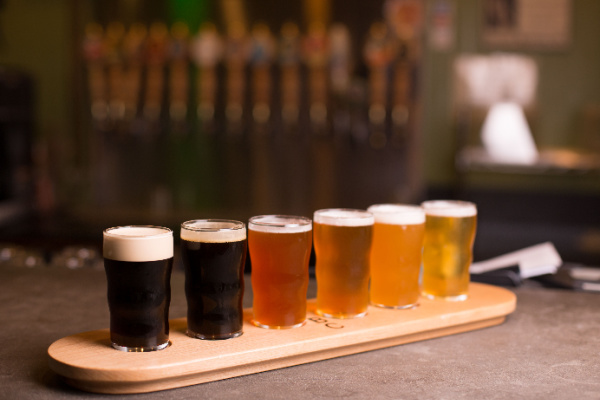Why Breweries Are Saying No to Beer Flights

They’re always happy to pour you a sample to taste, but more and more brewers are refusing to sell flights.
In a recent article that we came across in “Inside Hook”, By Mike Dunphy, he questions whether beer flights are more trouble than they’re worth? We’ve always taken the position that they are because if handled correctly, it provides an opportunity to explain your beers and to connect with your customer. But what do you think?
“I hate beer flights,” says Chris Lohring, owner and head brewer of Notch Brewing in Salem, Massachusetts. He’s not the only brewer to loathe the beer flight, either, but one of a small but growing coterie that intentionally keeps them off the menu.
Usually coming as a line of four or five small glasses atop a long, wooden board, beer flights became particularly popular amid the explosion of craft beer — and the breweries that make them — in the 2000s and 2010s. And they remain so, as countless images of them fill social media platforms, including about a half-million on Instagram alone.
Despite this undeniable popularity, Lohring and other brewers stick to their anti-flight guns, and the reasons they do so raise important questions about the beer-drinking experience, brewery logistics, branding considerations and trends to come. Here are the top reasons why brewers just say no to flights.
Beer-Drinking Experience
Craft brewers care passionately about their work and want to deliver a proper and pure beer-drinking experience. Beer flights, they believe, dash that effort for a variety of reasons:
Glassware: The shape, design and material of each glass impact the taste and aroma of beer inside. That’s why pilsners come in tall, thin glasses; DIPAs in tulip glasses; and wheat beers in weizen glasses. Flights, on the other hand, tend to come in a uniform set of glasses that does not fit the beer inside and provide the best experience of it. This is a big reason why brewers generally prefer to offer half-measures in the proper glassware as samples.
Volume: Much like the question of how many licks it takes to get to get to the Tootsie Pop center, how many sips does it take to fully taste a beer? The precise amount remains a debate — five ounces, eight ounces or a full pint — but it’s definitely more than the typical amount poured in a flight. “I don’t think anyone should be drinking out of 4-ounce thimbles,” Lohring says. “It’s not the proper head; it’s not the way the beer is going to be poured normally, you’re just not going to get the full experience of the beer.” That’s echoed by Jeanne Kitayama, co-owner of Haines Brewing, which also does not offer flights: “Five ounces is the smallest portion we will pour for a customer, as we know that it takes more than a sip to truly taste a beer.”
Palate Contamination: Beer heavily hits the palate, peppering the taste buds with a blend of hop bitterness, malty sweetness, flavor infusions and everything in-between. Those flavors grow and develop as you drink your beer, too. When you drink a flight, though, you essentially pound your palate with a number of flavor profiles that get lost in each other, even numbing your tastebuds altogether. Mixing certain beer styles and strengths makes it even worse. “Some beer styles clash with each other,” explains Paul Wheeler, co-owner of Haines Brewery, “and going back and forth from one style to another in succession is a bad idea.”
Temperature and carbonation: Each style of beer flowers to its fullest flavor at a certain temperature, usually between 40 and 50 degrees Fahrenheit. A full pint maintains that temperature longer than a small flight glass, both because of the larger volume and faster consumption. In flights, the small amount of beer inside heats up faster, especially if last in line in a casual drinking session. This applies to carbonation, too, as the passing time and increasing temperature makes the beer go flatter faster than it otherwise would in a full pint. The result is often a flavor that is subpar and unintended.
Logistics and Service
Philosophy sometimes must bow to logistics, and even if a brewery wants to offer flights, they may simply not be able to. And many that won’t point to these logistical challenges.
First of all, there’s the time it takes to explain the flight to the customer, help them choose the beers, put it together, deliver it, and then clean the whole thing after. That makes them especially problematic in high-volume taprooms or those with limited staffing. “There are 500 people here sometimes,” Lohring points out. “There’s no way we can do flights. The line would be down the street, and the service would be horrible.”
Allagash Brewing in Portland, Maine — which wants to serve flights — nevertheless does not serve them for these reasons. As its website states, “Custom flights are consistently time-consuming to fulfill, so we have made the difficult decision to hold off on offering flights for now in an effort to ensure that all of our guests will be able to get a chalice of beer in their hands as quickly as possible.”
While that reason, written in 2020, is less a problem today, Allagash admits, it still refrains from serving flights for logistical reasons — this time, storage. “The bigger reason is that we truthfully don’t have enough space for a third style of glassware in our outdoor bar/tasting space,” says hospitality director Emily Wallace.
Pricing and Profit
For some brewers, like Mark Osborne, owner of Adroit Theory Brewing in Virginia, flights represent a loss of income because they are a bundled product. That means the cost of each beer included in a flight needs to be averaged out to a single price for the lot. That often means more expensive-to-produce beers are reduced to a price below the cost of production or profit.
“I don’t like the idea of discounting my beer, which is what a flight is,” explains Osborne. “It’s almost always a bundle discount, which frankly, annoys the fire out of me.” Averaging out the costs, especially if there are multiple flight options, makes the idea even worse for Osborne: “Administratively, it just doesn’t make a lot of sense to me,” he says.
The alternative is to jack up the price and charge a premium, which is becoming more common, and earning the ire of some customers.
Brand Image
Younger brewers are also reconsidering beer flights for branding reasons, as noted by 27-year-old Julian Arena, co-founder of Outside Brewery near Asheville, North Carolina. “I think flights are a relic of that bygone era of the dadverse,” Arena states, referring to the earlier waves in the craft brewing revolution. “What doesn’t Gen Z like?” he adds. “They don’t like things their dad likes. Whatever my dad thought was cool in 2006 is not cool to me.”
Plus, he points out, young beer drinkers generally often don’t have the ability to make such decisions about what they want to try. “Put yourself in the perspective of someone who just turned 21,” he says. “You go to a brewery and see 18 taps? … It’s so overwhelming. They want simplicity. So, they typically just order whatever their friend tells them to get.”
Another consideration is the brand distinction from other breweries. Because most breweries offer flights, it creates a kind of monoculture, believes Lohring, with consumers going brewery to brewery and getting the same experience everywhere they go. “I’ve never understood that,” he reflects. “Why would you even go to another brewery if you’re going to have the same experience everywhere?”
Extending a Hop Branch
While some brewers do scoff at offering beer flights, they are always happy to give samples, usually in small pours of five to 10 ounces. This makes sure it’s at least served in the appropriate glass and sufficient volume to fully taste.
In fact, at Adroit Theory Brewing, customers buy more samples than pints. “We don’t sell many pints,” explains Osborne. “You walk into our brewery, and you’ll see 12 beers lined up in front of somebody, and they’re going through all of them. Maybe they’ll order a pint, but after 12 5-oz samples…they’re done.”
At Notch, Lohring follow the Czech and German model by offering a šnyt (shnit) — defined by Pilsner Urquell as “two parts beer, three parts foam and one part empty space at the top of the glass.” This is far closer to the pure beer-drinking experience than a flight, and perhaps another reason why flights are far less common in Europe.
Another reason the sample approach appeals to brewers is that it offers a better opportunity to educate the consumer. “I honestly think the flight is almost a crutch that some people lean on to say, ‘Here’s the flight. That’s good enough; that should be self-explanatory,’” explains Arena. “We want to walk you through. ‘Tell me what you like, what do you normally drink? Can I get you to try this? Can I get you to try that?’ And then we’ll work through it with you to find something that you like.”
Smaller taprooms, where there’s less turnover, may fit flights better, admits Osborne. “In that scenario — where you have a lot of the same things, the ABVs are similar, and the cost of making those beers is similar — it makes sense to do a flight.” But that’s not the case at Adroit, where, as he points out, “We make new stuff all the time.”
To Flight or Not to Flight
For the customer, choosing a flight or not depends on the primary goal. If it’s to fully experience a beer and enjoy its best presentation, then flights are not a great option. But if your visit to the brewery is purely about meeting friends, snapping flight selfies and having fun, beer flights may be the best way to take off.
Attribution: Article Retrieved from Inside Hook, written By Mike Dunphy .

Beer CPA – “We Give Craft Breweries More Freedom and Peace of Mind”
A Craft Brewery CPA Firm that’s Tech Savvy, Responsive, and Business Smart.
Photo Credit: Shutterstock



